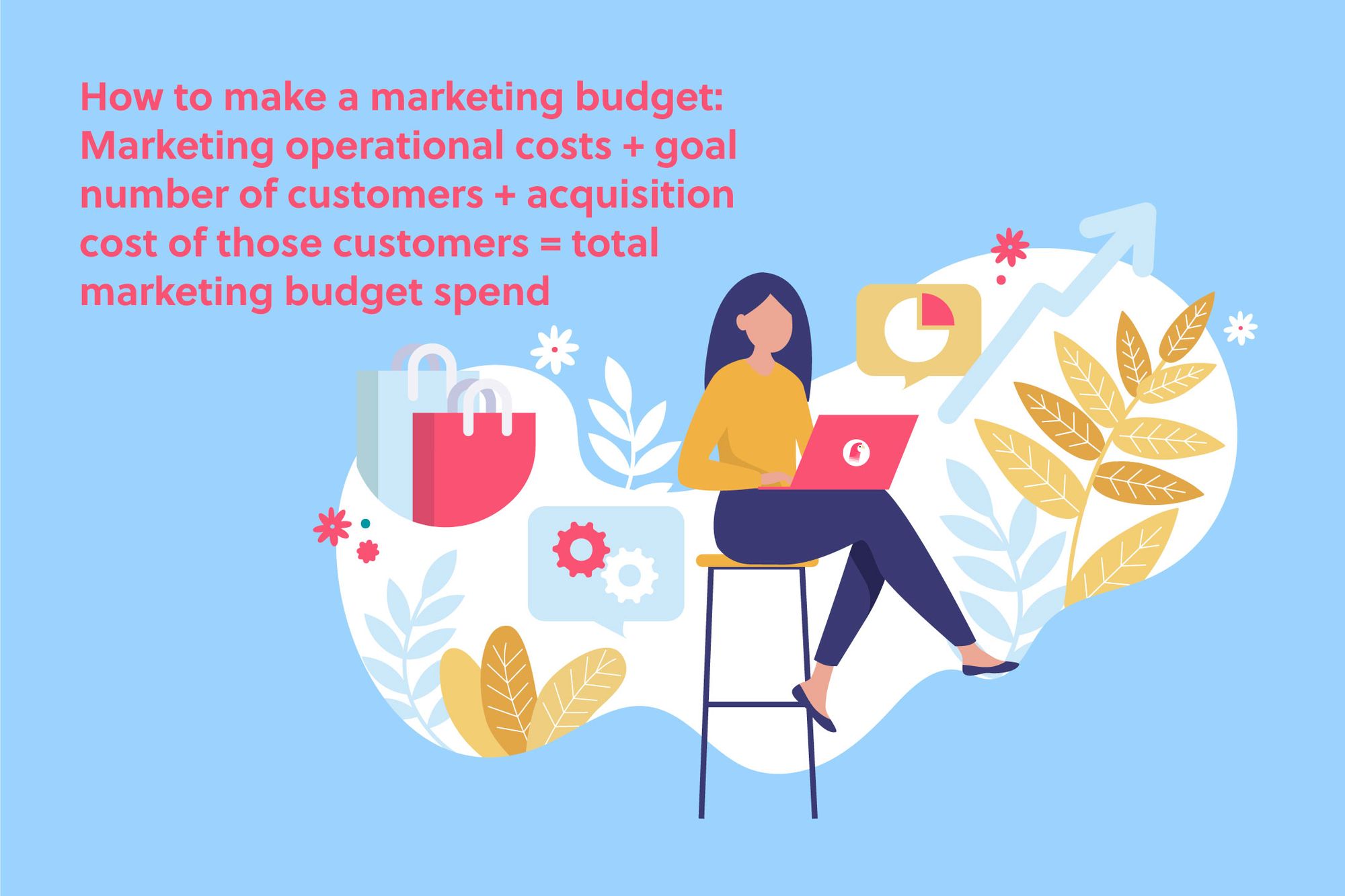The phrase “marketing budget” makes even the most experienced marketers groan.
Putting together a marketing budget is traditionally a very painful affair because it’s just not something that marketers are trained for.
We are taught how to choose the perfect action verb, the right Call To Action (CTA) color, or the ideal meme, but for some reason, no one ever trains us on budgeting.
And as a result, 50% of SMBs don’t even bother to make a marketing budget according to OutboundEngine’s research.

But we have good news for you: marketing budgets don’t have to be that hard. 💵💵💵
With the right practices, you can come up with a solid budget for your marketing initiatives. Read on to discover how to do just that.
What is a marketing budget?
A marketing budget outlines your planned marketing spend during a chosen time frame, typically a year or quarter. The budget will include things like the cost of your marketing employees’ salaries, software used specifically for marketing purposes, advertising, and other activities.
The budget provides visibility for leadership into the marketing team’s spend and helps the marketing team stay on track financially throughout the given time frame.
Step 1. Determine Your Total Budget Spend
Before you can start to allocate funds, you need to know how much total funds there are to allocate. There are a few ways to determine how much cash you need to spend over the year or quarter.
- Your boss (or you) or your accountant tells you what your budget is. It’s not uncommon for the company’s owner to put together their own budget for marketing, based on how much money is in the bank and how the business is doing financially.
- The budget is a percentage of total company revenue. For instance, the marketing department gets 11.2% of the company’s revenue to spend in the upcoming year. (11.2% is the average percentage of revenue allocated towards marketing.) This method is even more arbitrary than the previous one. The percentage is often chosen based on what others in your industry are spending on their marketing, rather than anything to do with your company’s efforts and results.
- Your marketing goals determine the total spend. This method is the most likely to result in accurate budgeting since it takes into account your plans.

How to figure out your goal-based spend
You can use a simple formula to determine your goal-based spend:
Marketing Operational Costs + (Goal Number * Goal Acquisition Costs) = Total Budget Spend
Marketing operational costs are the costs required to run your marketing initiatives. Things like marketing staff’s salary, software, and certification costs get accounted for here.
After that, you need to take your goal(s) into account. For instance, you have a goal of converting 100 new customers in the next year. That’s your goal number. To determine how much that costs, you multiply it by your customer acquisition cost, either ideal or historic average. So if your average CAC is $10, your planned spend for your conversion goal is $100.
For a team with a $10,000/year operational expense, their marketing budget would therefore be $11,000. ($10,000 + (100 * $1000) = $11,000.)

Step 2. Allocate the Budget
Once you’ve determined your total spend, it’s time to allocate the funds to specific things.
The first thing to allocate is your operational expenses. This is especially true if your total spend was chosen by a method other than goal-based. The other methods leave you needing to figure out how much money is available for your goals.
In general, your other planned costs will breakdown into:
- New hires. If you plan to expand the team, you’ll need to add budget for their salaries, onboarding and recruitment, and technology expenses.
- Agencies and freelancers. If you need extra help without hiring a new set of hands, you’ll want to set aside a monthly budget for agencies or freelancers to take on specialized activities.
- Advertising. If you’re planning to pay for leads or brand awareness, you’ll need to allocate spend for your ads. This could be spent on print media, social media advertisements, social media influencer promotions, search engine ads, podcast ads, etc.
- Content creation. The creation of blog posts, videos, podcasts, infographics, and other types of content require budgeting for human time and technology. Because of the overlap, content creation budgets may get rolled into a number of the other areas like your marketing operational or freelancer expenses.
Choose Your Channels
In order to determine how much you’ll be spending on the above, you’ll need to do some high-level strategizing on what channels you’ll use to drive your goals.
For instance:
- You plan to create one blog post a week to drive leads from organic search traffic.
- You will run Instagram and Facebook ads for one month to collect paid leads.
- You will use marketing automation to nurture and convert said leads.
With just this simple plan, you can allocate the budget like so:
- Salary for a content writer or budget for a freelancer to write your blog posts.
- Budget for your content management software.
- Salary for a digital advertising specialist or budget for freelancers to create your social ads.
- Budget for the ads themselves.
- Budget for a freelancer to implement or maintain your marketing automation apparatus.
- Budget for the marketing automation software.
Of those above expenses, quite a few may fall into operational expenses, like the salaries or software costs.
Whatever doesn’t fall into operational costs should be estimated out of the remaining total based both on existing knowledge of such expenses coupled with an idea of how much you’re willing to spend.
For instance, to create a budget for a month of social media advertisements, we’d have to consider a few things:
- Our average cost per lead of an ad (say $10.00)
- The number of leads we’d like to collect (for instance, 50)
- And the amount of remaining budget we actually have.
With this information, we know our ideal number of leads will cost us $500. If there’s room for that, we can throw that number into our budget as is.
However, if we were to only have $300 left to spend on the project, we’d need to lower our planned number of leads to 30 and figure out a way to drive the other 20 leads organically from our operational costs.
Alternately, you could cut $200 elsewhere and move it to this budget if you consider social media ads to be more important than something else to your plan.
Step 3. Manage Your Spending to not go Over Budget
Once your budget is in place and approved, it’s time to set up tracking so that you can monitor your total actual spend. This is all about tracking your Key Performance Indictators (KPIs). While your goals will determine which KPIs monitor your spend, here are the two most teams will track:
- Customer acquisition cost. This number should be tracked both as a total and as an average of individual cost. This number can, and typically should also be broken down further by channel spend. You can monitor whether your Instagram ads are too expensive, for instance, and move that spend to retargeting ads.
- Conversion rates. Any effort you run will have a conversion rate. That rate could measure anything from clicks to email sign ups, or clicks to customer conversions. The conversion rate doesn’t necessarily track spend, but it will help you determine which efforts are providing the most returns. When paired with the amount spent on various channels and how much money you have left to spend, conversion rates will enable you to make smart game-time decisions about re-allocating budget.
In addition to tracking your actual spend, you should also track the revenue driven by your measures. This revenue will help determine the success or failures of your efforts, determining what projects you should double down on. Revenue driven can also provide justification for your spend if you do end up over budget. Some revenue KPIs include:
- Total new customers driven
- Customer lifetime value (LTV)
- Return on investment of your various endeavors.
Wrapping Up
To create a good marketing budget, you need to be tracking your KPIs closely throughout the year. This reporting will give you data to reference during your budgeting season and make drawing up a new budget much easier.
If you’ve never made a marketing budget and you haven’t been reporting on your efforts, start by doing as much reporting on the past year’s efforts as you can.
Good luck, and get in touch with us if you have any burning marketing questions!

